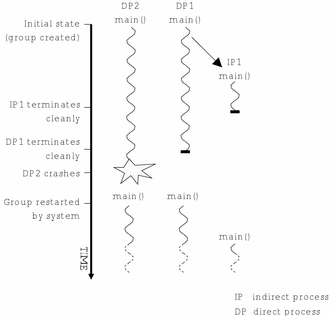Clean Termination
Any process that exits before the expected completion of its task is considered to have aborted abnormally and will cause a restart of its process group. This can be useful for cases where the process exits prematurely as a result of an error. This mechanism can also be useful for invoking a process restart where this is required, for example, if an execution problem is detected.
To enable a restartable process to terminate cleanly without causing a restart, use the HR_EXIT_HDL() macro prior to the call to exit(3STDC):
#include <hr/hr.h> HR_EXIT_HDL();
The purpose of the preceding macro is to add an additional hot restart exit handler to the process's atexit(3STDC) function. The hot restart exit handler effectively removes the process in question from the Hot Restart Controller's responsibility. After a process has called HR_EXIT_HDL(), the Hot Restart Controller will no longer monitor the process for abnormal termination. As a result, when the process exits, it will terminate cleanly and not trigger a restart.
The HR_EXIT_HDL() macro should be called shortly before the process exits. Calling this macro earlier in the process code will mean that any unexpected exit between the macro call and the final exit will not be detected by the Hot Restart Controller. As a result, the process will not be restarted if it exits abnormally.
Cleanly terminating a process does not unregister the process in the Hot Restart Controller or remove the process's process image and executing image from persistent memory. This is because a cleanly terminated process will still be restarted if its group is restarted (because a group is always restarted in its initial state). In other words, when a group is restarted, all direct restartable processes will recommence execution at their initial entry point, regardless of whether or not they had already exited before the restart occurred. This is demonstrated by the following diagram. Both direct process one (DP1) and indirect process two (IP2) terminate cleanly, but are automatically restarted when direct process two (DP2) crashes.
Figure 15-1 Restart of Cleanly Terminated Processes

Because of this behavior, it is useful to record the clean termination of restartable processes that will never require being reexecuted completely during a group's life by setting a flag in persistent memory. A restarted process can check the state of this flag at the start of its execution, and therefore detect whether it should re-execute or not.
- © 2010, Oracle Corporation and/or its affiliates
